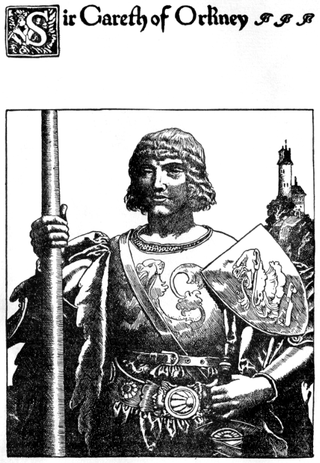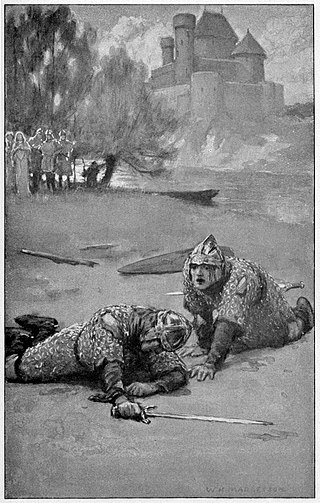
Excalibur is the mythical sword of King Arthur that may possess magical powers or be associated with the rightful sovereignty of Britain. Traditionally, the sword in the stone is the proof of Arthur's lineage. The sword given to him by the Lady of the Lake is not the same weapon, even though in some versions of the legend both of them share the name of Excalibur. Several similar swords and other weapons also appear within Arthurian texts, as well as in other legends.
Sir Thomas Malory was an English writer, the author of Le Morte d'Arthur, the classic English-language chronicle of the Arthurian legend, compiled and in most cases translated from French sources. The most popular version of Le Morte d'Arthur was published by the famed London printer William Caxton in 1485. Much of Malory's life history is obscure, but he identified himself as a "knight prisoner", apparently reflecting that he was either a criminal, a prisoner-of-war, or suffering some other type of confinement. Malory's identity has never been confirmed. Since modern scholars began researching his identity the most widely accepted candidate has been Sir Thomas Malory of Newbold Revel in Warwickshire, who was imprisoned at various times for criminal acts and possibly also for political reasons during the Wars of the Roses. Recent work by Cecelia Lampp Linton, however, presents new evidence in support of Thomas Malory of Hutton Conyers, Yorkshire.

Gawain, also known in many other forms and spellings, is a character in Arthurian legend, in which he is King Arthur's nephew and one of the premier Knights of the Round Table. The prototype of Gawain is mentioned under the name Gwalchmei in the earliest Welsh sources. He has subsequently appeared in many Arthurian tales in Welsh, Latin, French, English, Scottish, Dutch, German, Spanish, and Italian, notably as the protagonist of the Middle English poem Sir Gawain and the Green Knight. Other works featuring Gawain as their central character include De Ortu Waluuanii, Diu Crône, Ywain and Gawain, Golagros and Gawane, Sir Gawain and the Carle of Carlisle, L'âtre périlleux, La Mule sans frein, La Vengeance Raguidel, Le Chevalier à l'épée, Le Livre d'Artus, The Awntyrs off Arthure, The Greene Knight, and The Weddynge of Syr Gawen and Dame Ragnell.

Idylls of the King, published between 1859 and 1885, is a cycle of twelve narrative poems by the English poet Alfred, Lord Tennyson which retells the legend of King Arthur, his knights, his love for Guinevere and her tragic betrayal of him, and the rise and fall of Arthur's kingdom.

Lancelot du Lac, alternatively written as Launcelot and other variants, is a popular character in Arthurian legend's chivalric romance tradition. He is typically depicted as King Arthur's close companion and one of the greatest Knights of the Round Table, as well as a secret lover of Arthur's wife, Guinevere.

Mordred or Modred is a major figure in the legend of King Arthur. The earliest known mention of a possibly historical Medraut is in the Welsh chronicle Annales Cambriae, wherein he and Arthur are ambiguously associated with the Battle of Camlann in a brief entry for the year 537. Medraut's figure seemed to have been regarded positively in the early Welsh tradition and may have been related to that of Arthur's son. As Modredus, Mordred was depicted as Arthur's traitorous nephew and a legitimate son of King Lot in the pseudo-historical work Historia Regum Britanniae, which then served as the basis for the following evolution of the legend from the 12th century. Later variants most often characterised Mordred as Arthur's villainous bastard son, born of an incestuous relationship with his half-sister, the queen of Lothian or Orkney named either Anna, Orcades, or Morgause. The accounts presented in the Historia and most other versions include Mordred's death at Camlann, typically in a final duel, during which he manages to mortally wound his own slayer, Arthur. Mordred is usually a brother or half-brother to Gawain; however, his other family relations, as well as his relationships with Arthur's wife Guinevere, vary greatly.

Galahad, sometimes referred to as Galeas or Galath, among other versions of his name, is a knight of King Arthur's Round Table and one of the three achievers of the Holy Grail in Arthurian legend. He is the illegitimate son of Sir Lancelot du Lac and Lady Elaine of Corbenic and is renowned for his gallantry and purity as the most perfect of all knights. Emerging quite late in the medieval Arthurian tradition, Sir Galahad first appears in the Lancelot–Grail cycle, and his story is taken up in later works, such as the Post-Vulgate Cycle, and Sir Thomas Malory's Le Morte d'Arthur. In Arthurian literature, he replaced Percival as the hero in the quest for the Holy Grail.

The Knights of the Round Table are the legendary knights of the fellowship of King Arthur that first appeared in the Matter of Britain literature in the mid-12th century. The Knights are a chivalric order dedicated to ensuring the peace of Arthur's kingdom following an early warring period, entrusted in later years to undergo a mystical quest for the Holy Grail. The Round Table at which they meet is a symbol of the equality of its members, who range from sovereign royals to minor nobles.

In Arthurian legend, Kay is King Arthur's foster brother and later seneschal, as well as one of the first Knights of the Round Table. In later literature he is known for his acid tongue and bullying, boorish behaviour, but in earlier accounts he was one of Arthur's premier warriors. Along with Bedivere, with whom he is frequently associated, Kay is one of the earliest characters associated with Arthur. Kay's father is called Ector in later literature, but the Welsh accounts name him as Cynyr Ceinfarfog.

Le Morte d'Arthur is a 15th-century Middle English prose reworking by Sir Thomas Malory of tales about the legendary King Arthur, Guinevere, Lancelot, Merlin and the Knights of the Round Table, along with their respective folklore. In order to tell a "complete" story of Arthur from his conception to his death, Malory compiled, rearranged, interpreted and modified material from various French and English sources. Today, this is one of the best-known works of Arthurian literature. Many authors since the 19th-century revival of the legend have used Malory as their principal source.

Gareth is a Knight of the Round Table in Arthurian legend. He is the youngest son of King Lot and Queen Morgause, King Arthur's half-sister, thus making him Arthur's nephew, as well as brother to Gawain, Agravain and Gaheris, and either a brother or half-brother of Mordred. Gareth is particularly notable in Le Morte d'Arthur, where one of its eight books is named after and largely dedicated to him, and in which he is also known by his nickname Beaumains.
Maleagant is a villain from Arthurian legend. In a number of versions of a popular episode, Maleagant abducts King Arthur’s wife, Queen Guinevere, necessitating her rescue by Arthur and his knights. The earliest surviving version of this episode names the abductor Melwas; as Maleagant, he debuts as Lancelot's archenemy in Chrétien de Troyes' French romance Lancelot, the Knight of the Cart. However, all surviving versions seem to be later adaptations of a stock narrative of significantly earlier provenance.

Gaheris is a Knight of the Round Table in the chivalric romance tradition of Arthurian legend. A nephew of King Arthur, Gaheris is the third son of Arthur's sister or half-sister Morgause and her husband Lot, King of Orkney and Lothian. He is the younger brother of Gawain and Agravain, the older brother of Gareth, and half-brother of Mordred. His figure may have been originally derived from that of a brother of Gawain in the early Welsh tradition and then later split into a separate character of another brother, today best known as Gareth. German poetry also described him as Gawain's cousin instead of brother.

Agravain is a Knight of the Round Table in Arthurian legend, whose first known appearance is in the works of Chrétien de Troyes. He is the second eldest son of King Lot of Orkney with one of King Arthur's sisters known as Anna or Morgause, thus nephew of King Arthur, and brother to Sir Gawain, Gaheris, and Gareth, as well as half-brother to Mordred. Agravain secretly makes attempts on the life of his hated brother Gaheris starting in the Vulgate Cycle, participates in the slayings of Lamorak and Palamedes in the Post-Vulgate Cycle, and murders Dinadan in the Prose Tristan. In the French prose cycle tradition included in Thomas Malory's Le Morte d'Arthur, together with Mordred, he then plays a leading role by exposing his aunt Guinevere's affair with Lancelot, which leads to his death at Lancelot's hand.

The Acts of King Arthur and His Noble Knights (1976) is John Steinbeck's retelling of the Arthurian legend, based on the Winchester Manuscript text of Sir Thomas Malory's Le Morte d'Arthur. He began his adaptation in November 1956. Steinbeck had long been a lover of the Arthurian legends. The introduction to his translation contains an anecdote about his reading them as a young boy. His enthusiasm for Arthur is apparent in the work. The book was left unfinished at his death, and ends with the death of chivalry in Arthur's purest knight, Lancelot of the Lake.

Balinthe Savage, also known as the Knight with the Two Swords, is a character in the Arthurian legend. Like Galahad, Balin is a late addition to the medieval Arthurian world. His story, as told by Thomas Malory in Le Morte d'Arthur, is based upon that told in the continuation of the second book of the Post-Vulgate cycle of legend, the Suite du Merlin.

Dinadan is a Cornish knight of the Round Table in the Arthurian legend's chivalric romance tradition of the Prose Tristan and its adaptations, including a part of Le Morte d'Arthur. Best known for his humor and pragmatism, he is a close friend of the protagonist Tristan. Dinadan is the subject of several often comedic episodes until his murder by Mordred and Agravain.
The Alliterative Morte Arthure is a 4346-line Middle English alliterative poem, retelling the latter part of the legend of King Arthur. Dating from about 1400, it is preserved in a single copy in the 15th-century Lincoln Thornton Manuscript, now in Lincoln Cathedral Library.

Brunor, Breunor, Branor or Brunoro are various forms of a name given to several different characters in the works of the Tristan tradition of Arthurian legend. They include Knight of the Round Table known as Brunor/Breunor le Noir, as well as his father and others, among them another former knight of Uther's old Round Table and the father of Galehaut.

The Boy's King Arthur was an abridged version of Sir Thomas Malory's Le Morte d'Arthur edited by Sidney Lanier and published in 1880. It was intended as a children's edition, alongside Lanier's other "Boy's" works. The original title, including its subtitle, was The Boy's King Arthur being Sir Thomas Malory's History of King Arther and his Knights of the Round Table. It was republished in 1950 under the title King Arthur and his Knights of the Round Table.

















